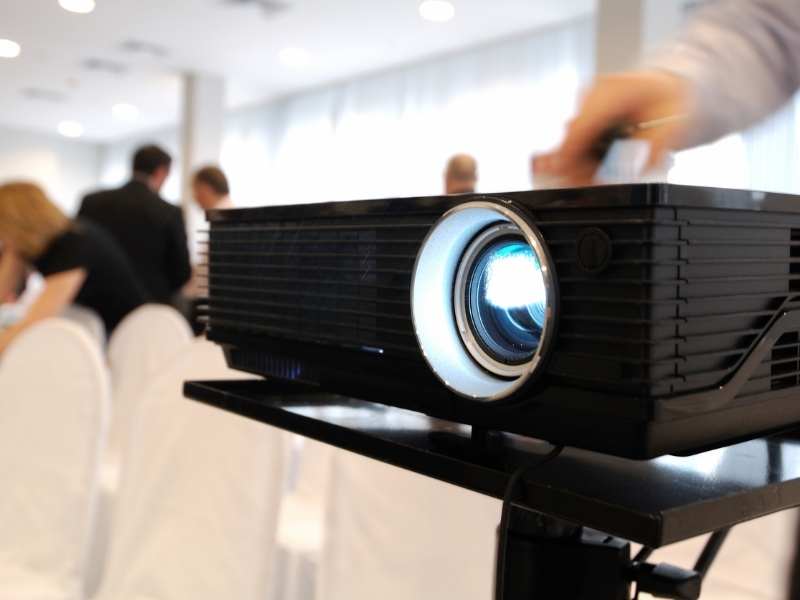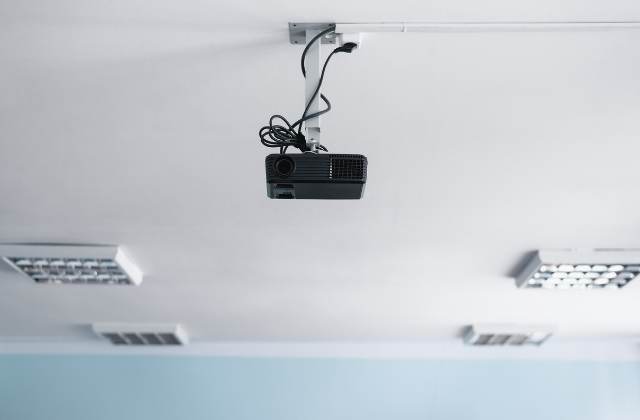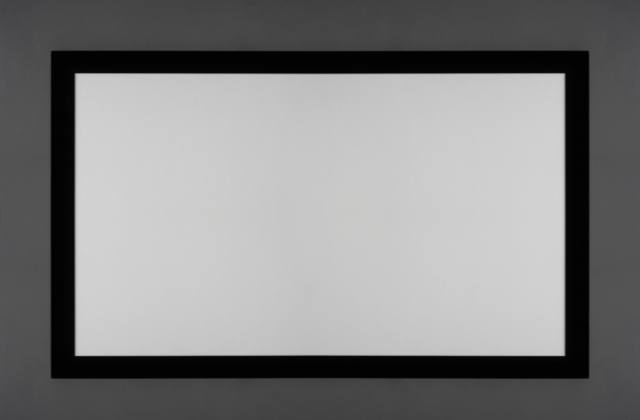As an Amazon Influencer, we earn from qualifying purchases you might make if you click any of the links or buttons on this page.
Looking for the best color for your projection screen?
With so many options for projector screens, you might be lost on the type you actually need. There are many different versions, with varied color projector screen types, and functionality.
So today, we’re going to show you exactly why the projector screen color matters, discuss the colors available and find the best color for projector screen suited to your needs.
What Do You Need The Projector Screen for?
Knowing what you need the projector screen for is the first step in the process.
Do you need a projector screen to watch movies in the living room?
Do you need it for presentations in bright offices?
Or a premium screen for your home theater?
Depending on your answer, the best projector screen color may be entirely different. Identify where and how you’re going to use the projector screen before moving to the next step.
We’ll outline some important factors that dictate the performance of different color projector screen types.
Factors to Consider When Choosing a Color For A Projector Screen
1) Ambient Light
Ambient light is the biggest consideration in choosing the best color for projector screens. Depending on how much light is present, you might need different screen colors.
For light-controlled rooms, you can opt for white or more light screen colors to get detailed and better depth image accuracy. Having no light in the room is the best place to use light screen colors.
For rooms with ambient lighting or daylight, your best option is to go for darker colors to enhance visual fidelity. This ensures bright images aren’t washed out from other light sources. Dark colors also help absorb light to reduce external light penetration.
Check the best projectors for bright rooms
2) Image Contrast Ratio
Another important thing to consider is the image contrast ratio.
Depending on your personal preferences, how much contrast images have, may or may not matter to you. Higher contrast means better black and white images, details, shading, and punchier images.
A white screen is universally the best at bringing out bright colors with punchy contrast in dim/dark lighting conditions. You’ll get bright whites and deep blacks with a white screen and a decent projector.
The darker screen material is ideal in rooms with daylight or a lot of ambient light. This helps keep a consistent black level, improving contrast. You’ll see better contrast for black details, but white brightness may decrease with gray or black projector screens.
To use dark materials, make sure your projector has at least a 3000 Lumens brightness.
In this case, you’ll have to sacrifice high-contrast screens to accommodate better brightness management. It isn’t ideal, but it’ll be a better experience overall.
3) Projector Screen Setup & Distance
Where and how your projector screen is placed also affects picture quality. Not everyone has a room darker than usual, specifically for the ultimate movie theater experience. Additionally, the further away projectors are from projector screens, the dimmer the image.
If you have a long or standard throw projector in a room with a lot of light, a gray screen or black screen is recommended.
Dark screens regulate external light while boosting the projector’s brightness settings. They compensate for projectors being further away and ensure enough light reaches the screen.
But viewing angles are lessened with black screens so you can only watch it straight on.
But for short-throw or ultra-short-throw projectors, you can still use a white projector screen in lit rooms as the short projection distance does not affect brightness as much.
4) Budget / Price Range
While the core difference in projector screen performance is substantial, how much money you want to spend is also important.
Depending on the above factors, figure out the best color for projector screen in your environment. Then choose between a black projector screen, a gray projector screen, or a cheaper white screen.
Black and gray screens are typically more expensive.
There are also premium white screens available which pair well with powerful projectors in lit-up rooms. Otherwise, white screens are very affordable.
It’s up to your personal preference and what you need. Want a higher contrast ratio? Ambient lighting management? Or an affordable option?
Depending on this, plan according to how powerful your projector is, how much light is present in the room, and how vibrant you want the picture quality to be.
5) Projector Performance
A projector screen can only do so much to create a quality image without additional help. Having a bright projector is as important as a good projector screen.
If your projector doesn’t have a high brightness but you’re using it in a dark room, white screens are optimal. White screens reflect light much better than dark colors in dimly lit rooms.
If your projector has a high brightness but low contrast, opt for gray or black screens as it will help keep a consistent black level. White brightness may lessen but your projector’s brightness will make up for that.
You need to consider how powerful your projector is in terms of brightness, dynamic contrast ratio, and resolution. For best results, get a screen color to make up for your projector’s performance.
Different Projector Screen Color Types
Black Projector Screens
Black projector screens were created to deal with ambient lighting.
Since it’s a pitch black screen material, weak projector brightness in ambient lit rooms is upgraded. Bright colors are also more visible when contrasted against black screens.
Dark details and shading are key on black screens, resulting in deep blacks, vibrant colors, and detailed images. To take full advantage of a black projector screen, you should use them in brightly lit rooms.
Black screens don’t reflect as much light and keep black levels consistent.
The problem with black projector screens is the limited supply, a high price tag, and limited versatility. They’re pricier than most white projector screens and gray screens. Black screens have lesser viewing angles so you don’t have as much flexibility as other screens.
White Projector Screens
A white projector screen is the most common of all projector screens.
They’re also the most affordable, making white screens the choice of enthusiasts and newcomers alike. It’s best suited for dark, traditional home theater setups as white screens project color-accurate, bright images in the right setting.
This is because of the reflective properties of white screens. This is a big reason it’s a standard for home theater enthusiasts and the like. They reflect light well which helps project crystal clear videos and content.
White screens are often see-through and easily interrupted by external light sources. They’re not suitable for bright lighting conditions. Unless you have a powerful projector to make up for the bright lights, you’ll see washed-out images.
But there are more expensive white screens that use higher quality materials to reduce this.
A white screen is also available at multiple price points, making it ideal if you’re on a budget.
Gray Projector Screens
The next type of screen is gray screens which are essentially white screens with a grayish tint. A grey projector screen is similar to a white screen but focuses on increasing contrast and decreasing light penetration.
Put white and gray screens in the same brightly lit conditions, and you’ll notice a contrast-rich, sharper image on the gray projector screen. They help to boost low Lumens projectors that don’t have powerful light output.
While they’re almost the same color, the gray tint greatly boosts images in lit-up environments. If you don’t have the cash for a black screen but want better light negation than traditional white screens, gray screens are a solid middle ground.
But they’re slightly more expensive than white screens which can influence your purchase decision. Take into account your lighting conditions and decide between the two.
Silver Projector Screens
Probably the oldest type of projector screens are silver screens. These were the choice for theaters when movies were relatively new. Talkies and Silent Films in the early 1900s used a silver screen to boost the low-powered projectors of the time.
A silver screen is often regarded as the best at reflecting as much light as possible, even from low brightness projectors. Silver screens are also known to be one of the best when you need the brightest image possible.
But you’ll also need a pitch-black environment for viewable results.
Compared to newer white or gray screens, silver screens are also more expensive. This is because it’s made with actual silver. They’re not realistic for home theater rooms with the huge price differences.
If you’ve got the money and want the old-timey film vibe though, silver screens are a solid choice for the best brightness, contrast, and clarity.
White or Gray Screen?
While there are four different types of projector screens, most consumers will have to choose between white and gray color screens. They’re the most affordable, cost-effective, and perform well enough for most users.
We’d recommend a white screen if you have a dedicated home theater room with black-out curtains and no light. White screens are still the best in the right situations.
We’d recommend a gray screen if your projector is set up in a living room with dim or bright lights. This helps regulate light penetration and contrast without losing on a bright image.
Either way, you’ll have a high-contrast image with bright colors. It really depends on your setup and personal preference.
FAQs
Is a Black Projector Screen Worth It?
A black screen is worth it if you have the money to buy it. It’s not necessary for now, but once you save up for a home theater upgrade, it’s a great investment for deep contrast and reducing light penetration.
Can I Project on a White Wall Instead of a Screen?
It’s not recommended to project on a white wall since walls often have imperfections and bumps that may affect the quality of the image. But getting the best projector screen paint is a great option if you don’t want the hassle of a screen. Projector screen paint isn’t as reliable, but it’ll get the job done.
Does Projector Type Affect Projected Image More Than the Screen?
Digital projectors affect image quality more than the screen itself. If you have a modern and relatively new projector, you’re set. But if your projector is dated, consider an upgrade to enjoy your new projector screen.
How Does Light Affect Image Quality?
Light other than from the projector will diminish visual fidelity as it takes the space on the projection surface. External light sources dim the projected image, washing out what you can see on screen.





